Springing Analysis of a Passenger Ship in Waves
Abstract
1. Introduction
2. Theoretical Background
2.1. Frequency Domain Hydroelastic Seakeeping Model
2.2. Decomposition of Dynamic and Quasi-Static Responses
2.3. Linear Spectral Approach
2.4. Rule-Based Wave Loads
3. Case Study
3.1. Structural Model
3.2. Hydrodynamic Model
4. Results
4.1. Dry Analysis
4.2. Wet Analysis
4.3. Steady State Load RAOs
4.4. Spectral Analysis
5. Conclusions
Author Contributions
Funding
Acknowledgments
Conflicts of Interest
References
- ILS. Shipping Statistics and Market Review, 61-No. 5/6; The Institute of Shipping Economics and Logistics (ILS): Bremen, Germany, 2017; ISSN 0947022. [Google Scholar]
- Hirdaris, S.E.; Temarel, P. Hydroelasticity of ships: Recent advances and future trends. Proc. Inst. Mech. Eng. Part M J. Eng. Marit. Environ. 2009, 223, 305–330. [Google Scholar] [CrossRef]
- Lloyd’s Register. Procedure for Strength Analysis of the Primary Structure of Passenger Ships; ShipRight Design and Construction, Structural Design Assessment (SDA), Lloyd’s Register Marine Business Stream: London, UK, 2017. [Google Scholar]
- Bajic, D. Structural design of passenger cruise ships—An introduction to classification requirements. Ships Offshore Struct. 2015, 10, 232–238. [Google Scholar] [CrossRef]
- Nitta, A.; Arai, H.; Magaino, A. Basis of IACS unified longitudinal strength standard. Mar. Struct. 1992, 5, 1–21. [Google Scholar] [CrossRef]
- Malenica, S. Hydrostructure interaction in seakeeping. In Proceedings of the International Workshop on Coupled Methods in Numerical Dynamics, Dubrovnik, Croatia, 19–21 September 2007; pp. 1–25. [Google Scholar]
- Bishop, R.E.D.; Price, W.G.; Tam, P.K.Y. A Unified Dynamic Analysis of Ship Response to Waves. Trans. R. Inst. Naval Archit. 1977, 119, 363–390. [Google Scholar]
- Hirdaris, S.E.; Price, W.G.; Temarel, P. Two- and three-dimensional hydroelastic modelling of a bulker in regular waves. Mar. Struct. 2003, 16, 627–658. [Google Scholar] [CrossRef]
- Bishop, R.E.D.; Price, W.G. An introduction to ship hydroelasticity. J. Sound Vib. 1983, 87, 391–407. [Google Scholar] [CrossRef]
- Bishop, R.E.D.; Price, W.G.; Wu, Y. A general linear hydroelasticity theory of floating structures moving in a seaway. Philos. Trans. R. Soc. Lond. Ser. A Math. Phys. Sci. 1986, 316, 375–426. [Google Scholar]
- Price, W.G.; Salas, M.; Temarel, P. The Dynamic Behavior of a Mono-hull in Oblique Waves Using Two- and Three-dimensional Fluid-structure Interaction Models. Trans. R. Inst. Naval Archit. 2002, 144, 1–26. [Google Scholar]
- Basaran, I.; Belik, O.; Temarel, P. Dynamic Behaviour of a Container Ship Using Two- and Three-Dimensional Hydroelasticity Analyses. In Proceedings of the 27th International Conference on Offshore Mechanics and Arctic Engineering, Estoril, Portugal, 15–20 June 2008; Volume 6, pp. 219–228. [Google Scholar]
- Malenica, S.; Molin, B.; Remy, F.; Senjanovic, I. Hydroelastic response of a barge to impulsive and non-impulsive wave loads. In Proceedings of the 3rd International Conference on Hydroelasticity in Marine Technology, The Oxford University, Oxford, UK, 15–17 September 2003; pp. 107–116, ISBN 0-952-62081-2. [Google Scholar]
- Lee, Y.; White, N.; Wang, Z.; Zhang, S.; Hirdaris, S.E. Comparison of springing and whipping responses of model tests with predicted nonlinear hydroelastic analyses. Int. J. Offshore Polar Eng. 2012, 22, 1–8. [Google Scholar]
- Bigot, F.; Derbanne, Q.; Sireta, F.X.; Malenica, S.; Tuitman, J.T. Global hydroelastic ship response comparison of numerical model and WILS model tests. In Proceedings of the 21st International Offshore and Polar Engineering Conference, Maui, HI, USA, 19–24 June 2011; ISOPE-I-11-138. [Google Scholar]
- Derbanne, Q.; Malenica, Š.; Tuitman, J.T.; Bigot, F.; Chen, X.B. Validation of the global hydroelastic model for springing & whipping of ships. In Proceedings of the 11th International Symposium on Practical Design of Ships and Other Floating Structures, Rio de Janeiro, Brazil, 19–24 September 2010; pp. 331–340, ISBN 9788528501407. [Google Scholar]
- Shin, K.; Jo, J.; Hirdaris, S.E.; Jeong, S.; Park, J.B.; Lin, F.; Wang, Z.; White, N. Two- and three-dimensional springing analysis of a 16,000 TEU container ship in regular waves. Ships Offshore Struct. Loads Ships Offshore Struct. 2015, 10, 498–509. [Google Scholar]
- Malenica, S.; Tuitman, J.T. 3DFEM-3DBEM Model for springing and whipping analyses of ships. In Proceedings of the International Conference on Design and Operation of Container Ships, The Royal Institution of Naval Architects, London, UK, 3–4 July 2008; pp. 13–22, ISBN 9781510885578. [Google Scholar]
- Im, H.I.; Vladimir, N.; Malenica, S.; Cho, D.S. Hydroelastic response of 19,000 TEU class ultra large container ship with novel mobile deckhouse for maximizing cargo capacity. Int. J. Naval Archit. Ocean Eng. 2017, 9, 339–349. [Google Scholar] [CrossRef][Green Version]
- Rajendran, S.; Vasquez, G.; Soares, C.G. Effect of bow flare on the vertical ship responses in abnormal waves and extreme seas. Ocean Eng. 2016, 124, 49–436. [Google Scholar] [CrossRef]
- Kim, J.H.; Kim, Y. Prediction of extreme loads on ultra-large containerships with structural hydroelasticity. J. Mar. Sci. Technol. 2018, 23, 253–266. [Google Scholar] [CrossRef]
- Jiao, J.; Jiang, Y.; Zhang, H.; Li, C.; Chen, C. Predictions of Ship Extreme Hydroelastic Load Responses in Harsh Irregular Waves and Hull Girder Ultimate Strength Assessment. Appl. Sci. 2019, 9, 240. [Google Scholar] [CrossRef]
- Malenica, S.; Derbanne, Q. Hydro-structural issues in the design of ultra large container ships. Int. J. Naval Archit. Ocean Eng. 2014, 6, 983–999. [Google Scholar] [CrossRef]
- BV. Homer 2.1.9 User Guide; Bureau Veritas VeriSTAR: Paris, France, 2019. [Google Scholar]
- BV. NR 583. Whipping and Springing Assessment; Bureau Veritas: Paris, France, 2015; Available online: http://erules.veristar.com/dy/data/bv/pdf/583-NR_2015-07.pdf (accessed on 3 July 2020).
- Lloyd’s Register. Global Design Loads of Container Ships and Other Ships Prone to Whipping and Springing; ShipRight Design and Construction—Structural Design Assessment (SDA), Lloyd’s Register Marine Business Stream: London, UK, 2018; Available online: https://www.lr.org/en/shipright-procedures/#accordion-structuraldesignassessment(sda) (accessed on 3 July 2020).
- BV. Rules for the Classification of Steel Ships. Part B—Hull and Stability. Chapter 5 Design Loads, Section 2 Hull Girder Loads; Bureau Veritas: Paris, France, 2019. [Google Scholar]
- IACS. Longitudinal Strength Standard S11. 2015. Available online: http://www.iacs.org.uk/publications/unified-requirements/ur-s/ (accessed on 3 July 2020).
- BV. NI 638. Guidance for Long-term Hydro-structure Calculations; Bureau Veritas VeriSTAR: Paris, France, 2019; Available online: http://erules.veristar.com/dy/data/bv/pdf/638-NI_2019-02.pdf (accessed on 3 July 2020).
- Newman, J.N. Wave effects on deformable bodies. Appl. Ocean Res. 1994, 16, 47–59. [Google Scholar] [CrossRef]
- Harding, R.D.; Hirdaris, S.E.; Miao, S.H.; Pittilo, M.; Temarel, P. Use of Hydroelasticity analysis in design. In Proceedings of the 4th International Conference on Hydroelasticity in Marine Technology, Wuxi, China, 10–14 September 2006; pp. 1–12. [Google Scholar]
- BV. StarSpec User Guide; Bureau Veritas VeriSTAR: Paris, France, 2016. [Google Scholar]
- Derbanne, Q.; Storhaug, G.; Shigunov, V.; Xie, G.; Zheng, G. Rule formulation of vertical hull girder wave loads based on direct computation. In Proceedings of the 13th International Symposium on Practical design of Ships and other Floating Structures, Copenhagen, Denmark, 4–8 September 2016; ISBN 9788774754732. [Google Scholar]
- DNV GL. Classification Guideline CG-0127. Finite Element Analysis; DNV GL AS Rules and Standards: Oslo, Norway, 2016; Available online: https://rules.dnvgl.com/docs/pdf/DNVGL/CG/2016-02/DNVGL-CG-0127.pdf (accessed on 3 July 2020).
- Avi, E.; Lillemäe, I.; Romanoff, J.; Niemelä, A. Equivalent shell element for ship structural design. Ships Offshore Struct. 2015, 10, 239–255. [Google Scholar] [CrossRef]
- Kaldoja, M. Modeling of Ship’s Side Shell Openings in Global Finite Element Models. Master’s Thesis, Aalto University, Espoo, Finland, 25 September 2017. Available online: http://urn.fi/URN:NBN:fi:aalto-201710307320 (accessed on 3 July 2020).
- Siemens. Femap User Guide; Version 2019.1; Siemens Product Lifecycle Management Software Inc.: Plano, TX, USA, 2019.
- NAPA Manuals; Release 2019.2; NAPA: Helsinki, Finland, 2019.
- Kumai, T. Damping factors in higher modes of vibrations. Eur. Shipbuild. Prog. 1958, 111, 29–34. [Google Scholar] [CrossRef]
- IACS. Recommendation No.34 on Standard Wave Data. 2001. Available online: http://www.iacs.org.uk/publications/recommendations/21-40/ (accessed on 3 July 2020).
- DNV GL. Classification Guideline CG-0130. Wave Loads; DNV GL AS Rules and Standards: Oslo, Norway, 2018; Available online: https://rules.dnvgl.com/docs/pdf/DNVGL/CG/2018-01/DNVGL-CG-0130.pdf (accessed on 3 July 2020).
- Malenica, S.; Tuitman, J.T.; Bigot, F.; Sireta, F.X. Some aspects of 3D linear hydroelastic models of springing. In Proceedings of the 8th International Conference on Hydrodynamics, Nantes, France, 30 September–3 October 2008; pp. 529–538. [Google Scholar]
- Parunov, J.; Senjanovi, I.; Paviaeeviae, M. Use of Vertical Wave Bending Moments from Hydrodynamic Analysis in Design of Oil Tankers. Trans. R. Inst. Naval Archit. 2004, 146, 10. [Google Scholar] [CrossRef]
- Jensen, J.J.; Pedersen, P.; Shi, B.; Wang, S.; Petricic, M.; Mansour, A. Wave induced extreme hull girder loads on containerships. Trans. Soc. Naval Archit. Mar. Eng. 2009, 116, 128–151. [Google Scholar]
- Rörup, J.; Rathje, H.; Schellin, T. Status of Analysis Methods for Hull Girder Torsion of Containerships. In Proceedings of the 4th PAAMES and AMEC Conference, Singapore, 6–8 December 2010; pp. 1–6. [Google Scholar]
- Bennett, S.S.; Hudson, D.A.; Temarel, P. The influence of forward speed on ship motions in abnormal waves: Experimental measurements and numerical predictions. J. Fluids Struct. 2013, 39, 154–172. [Google Scholar] [CrossRef]
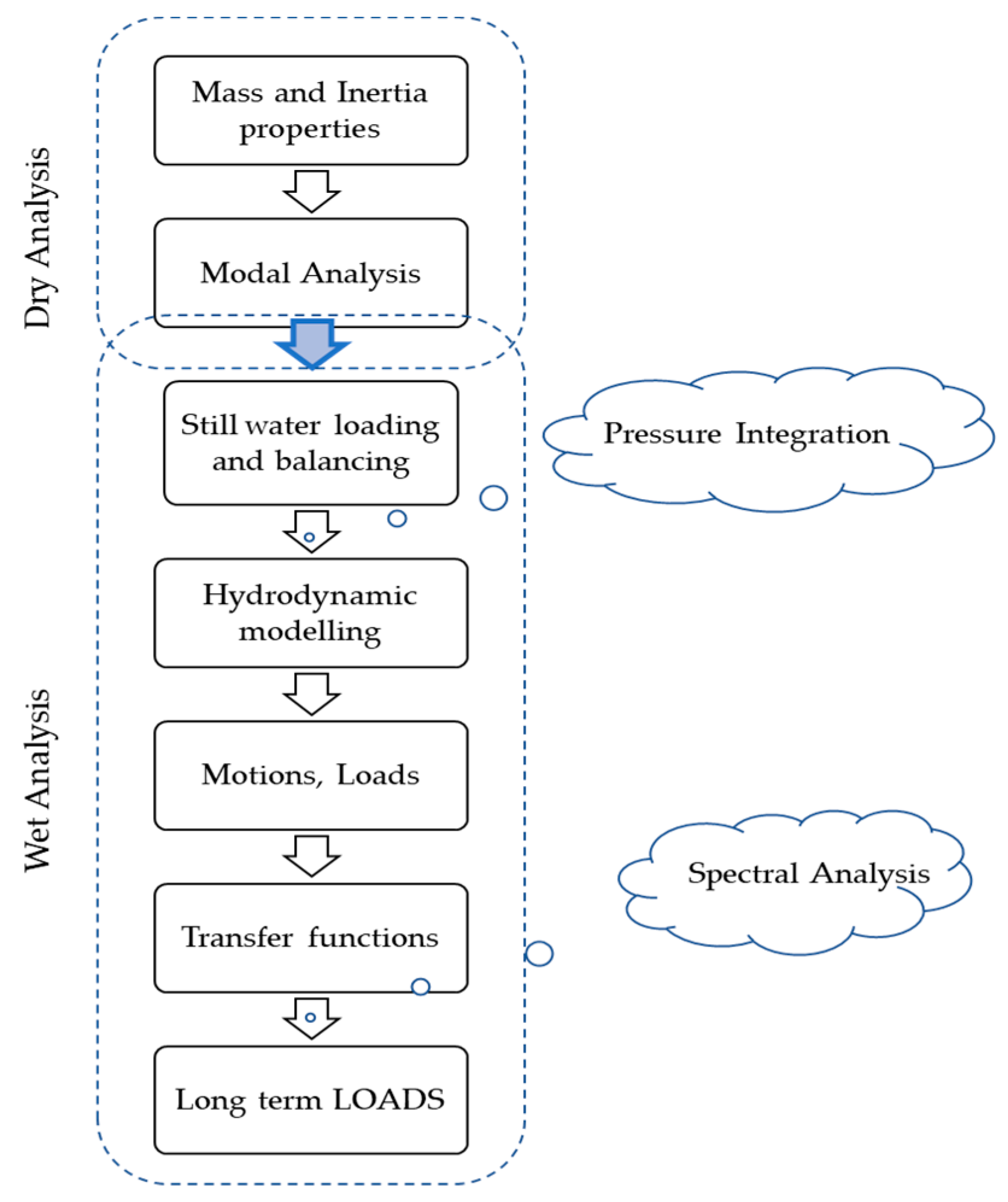


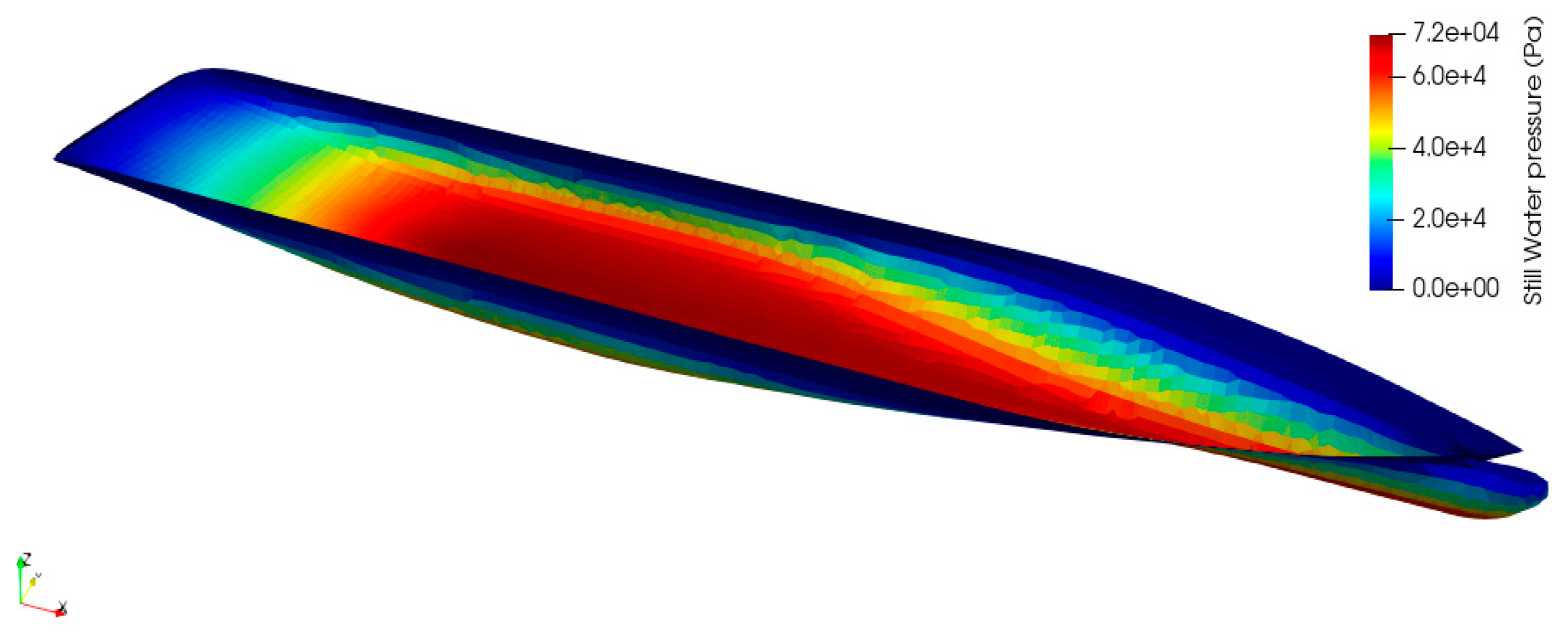

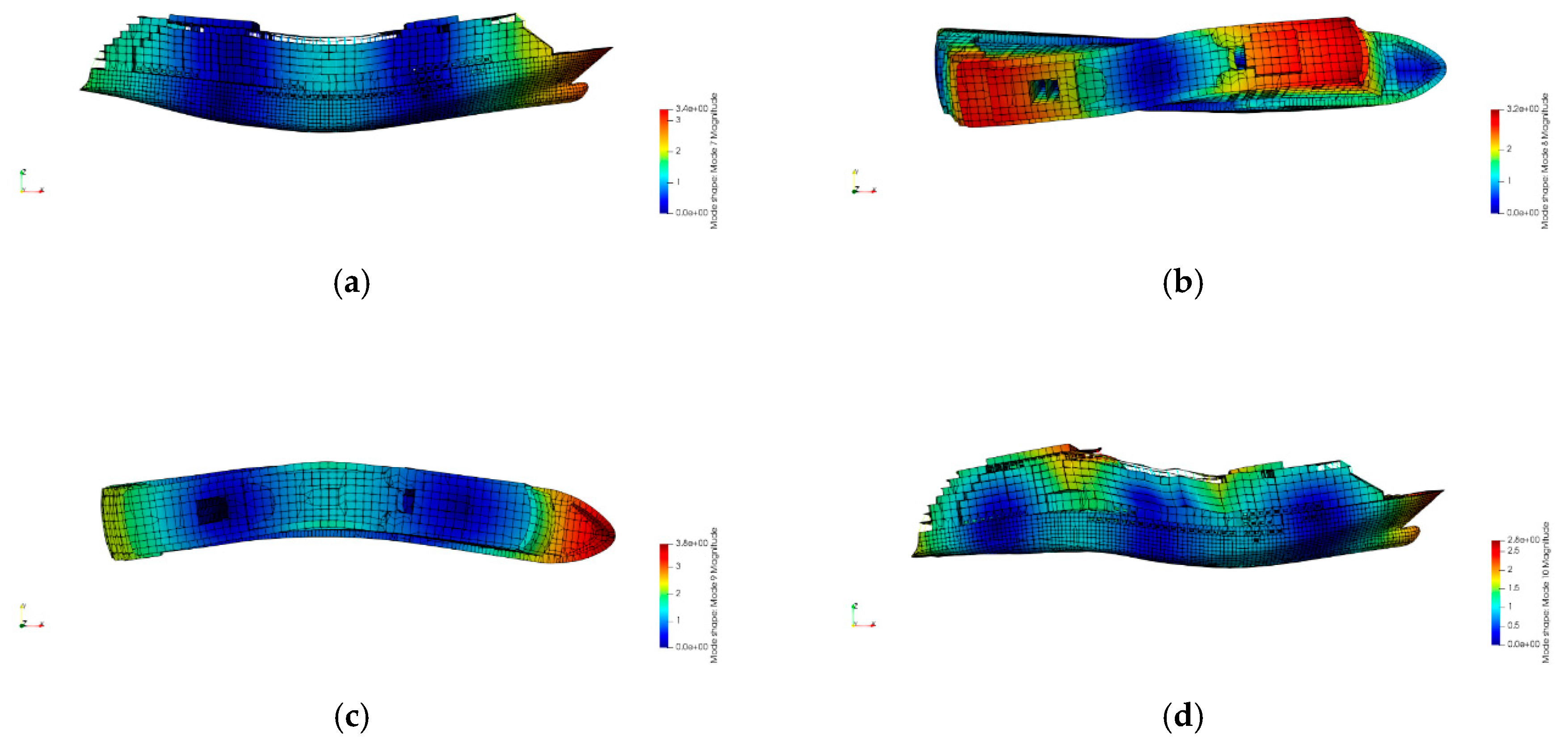

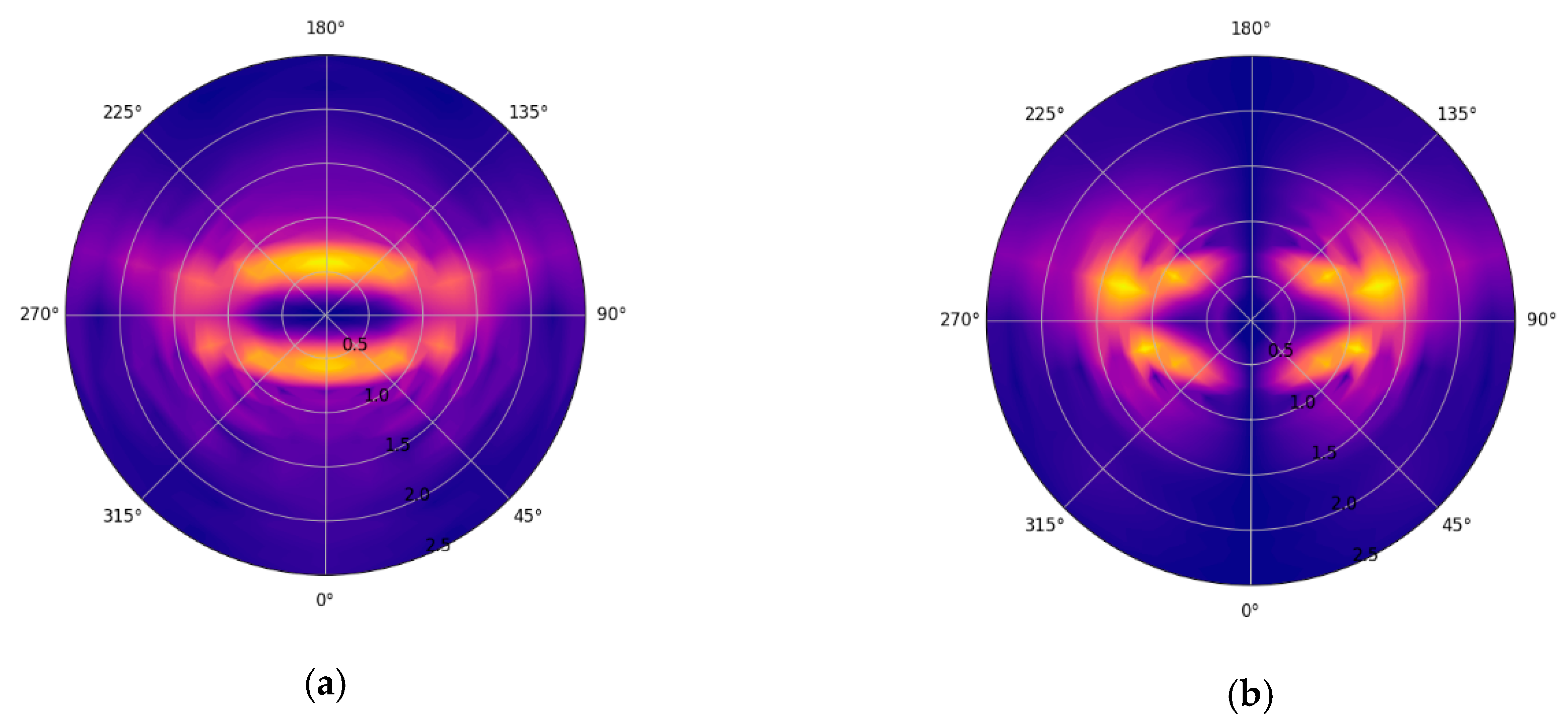
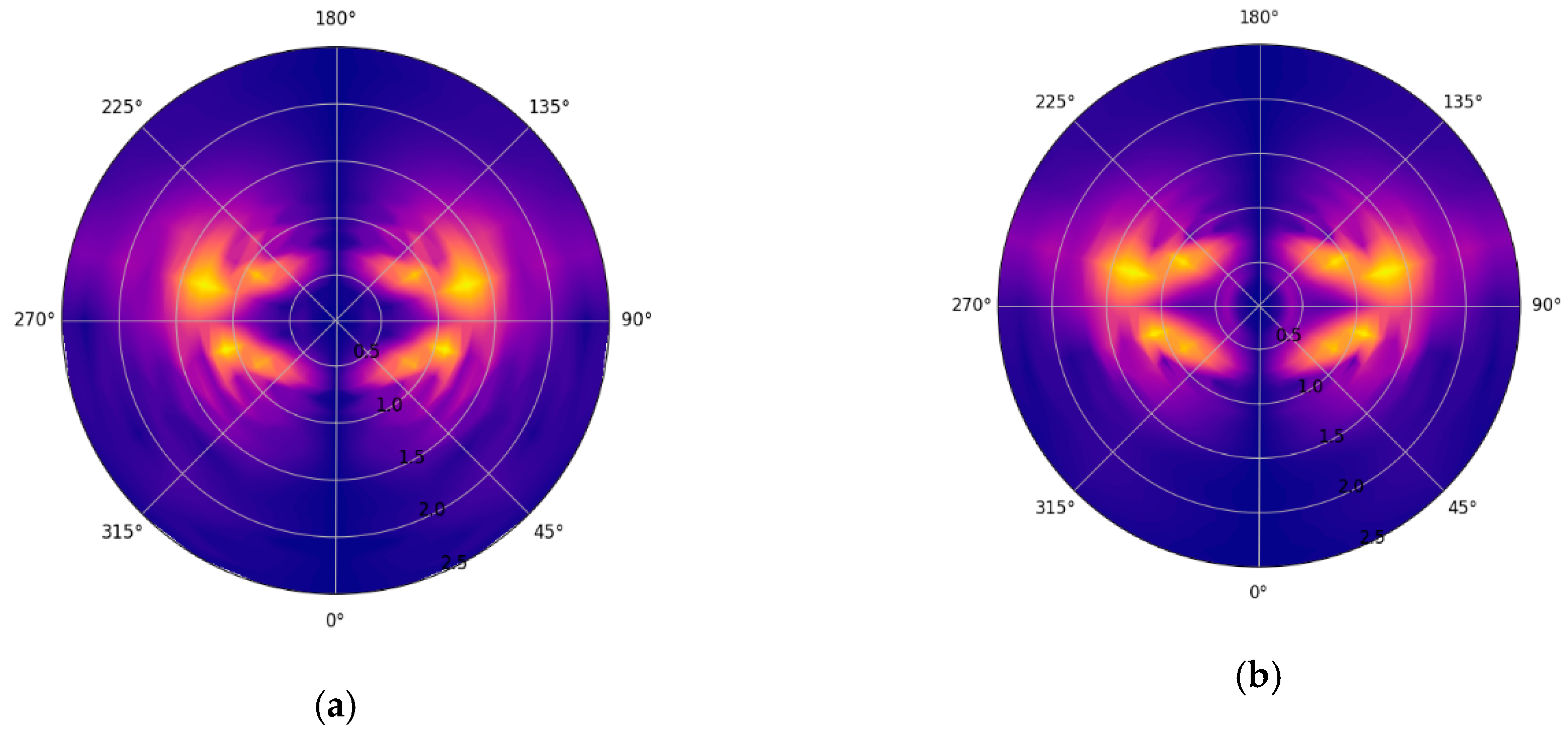
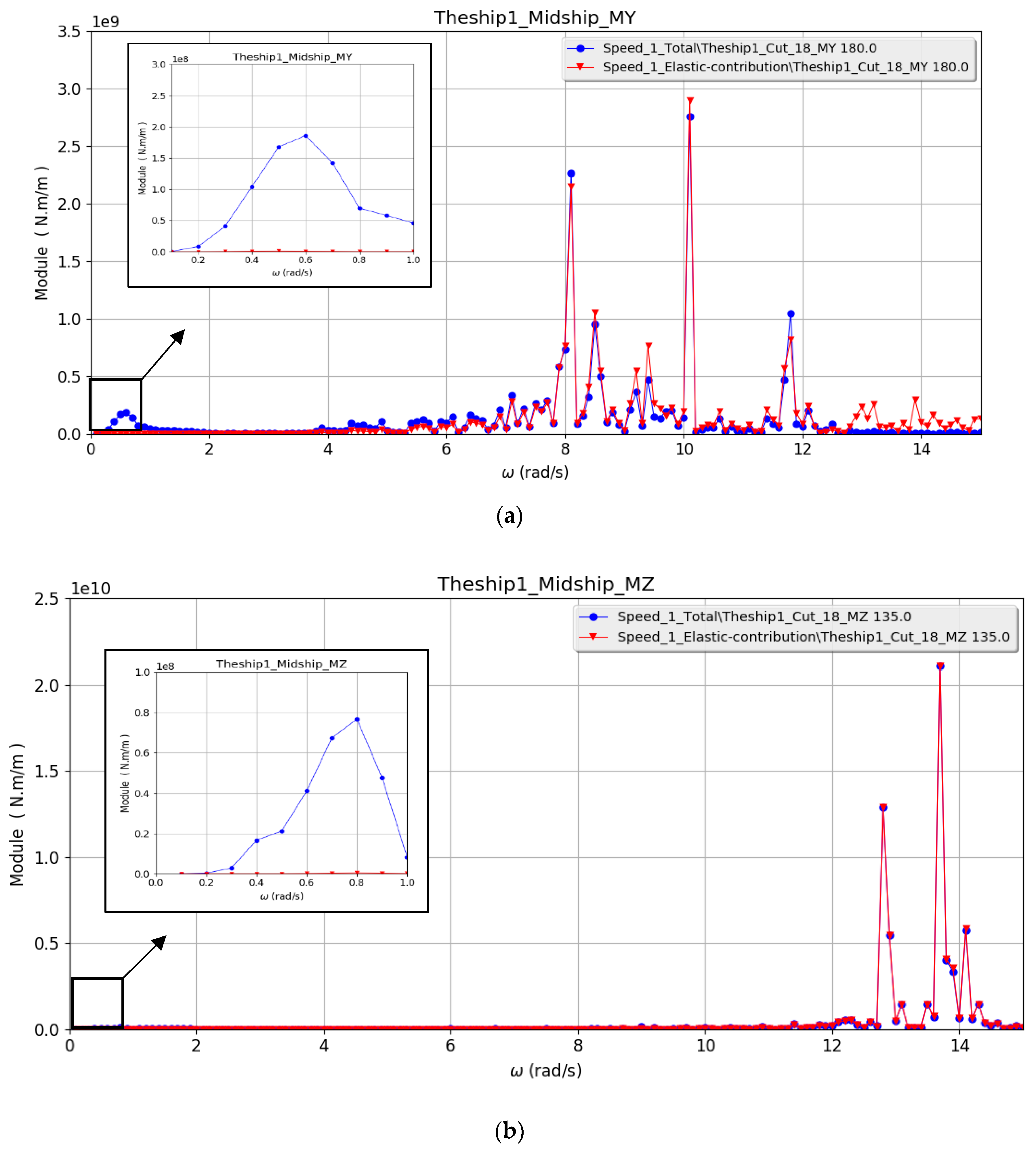
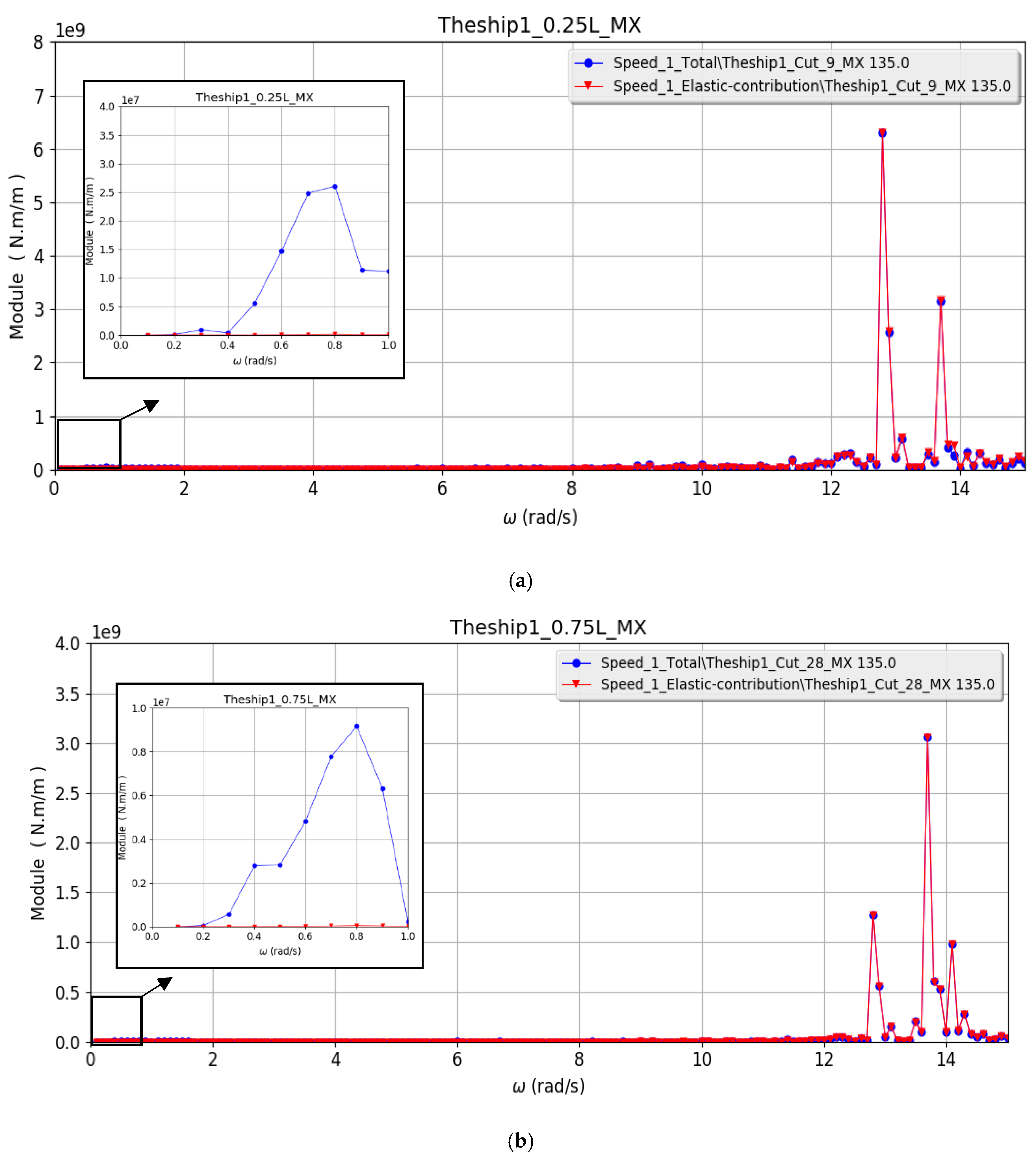
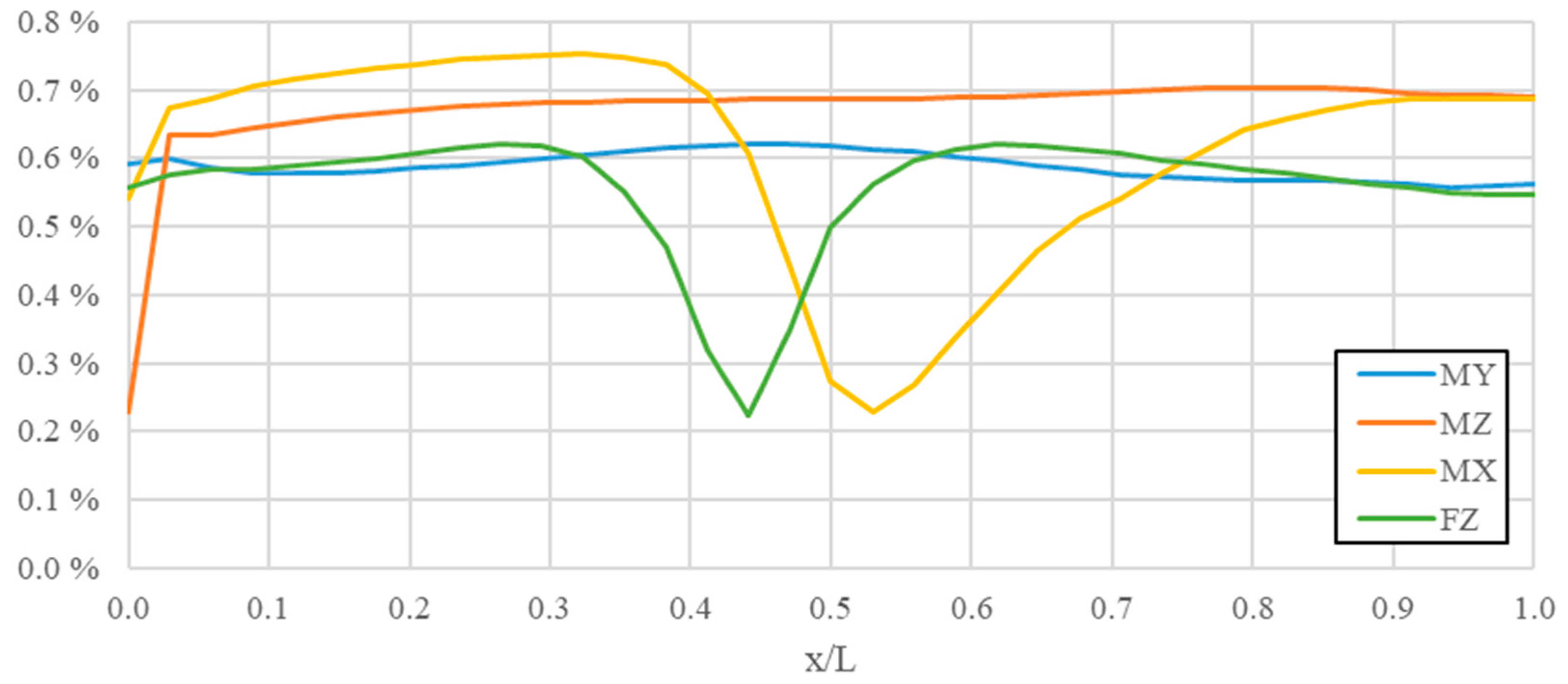
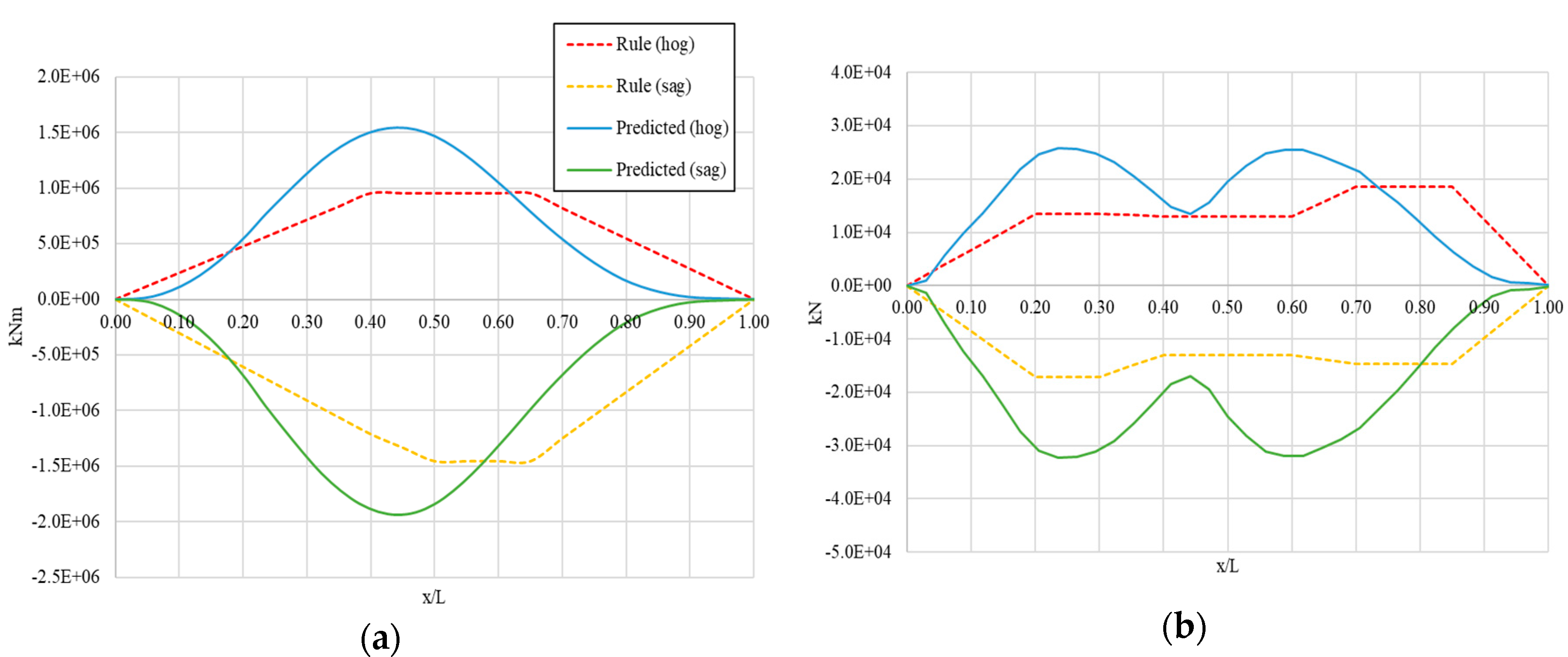
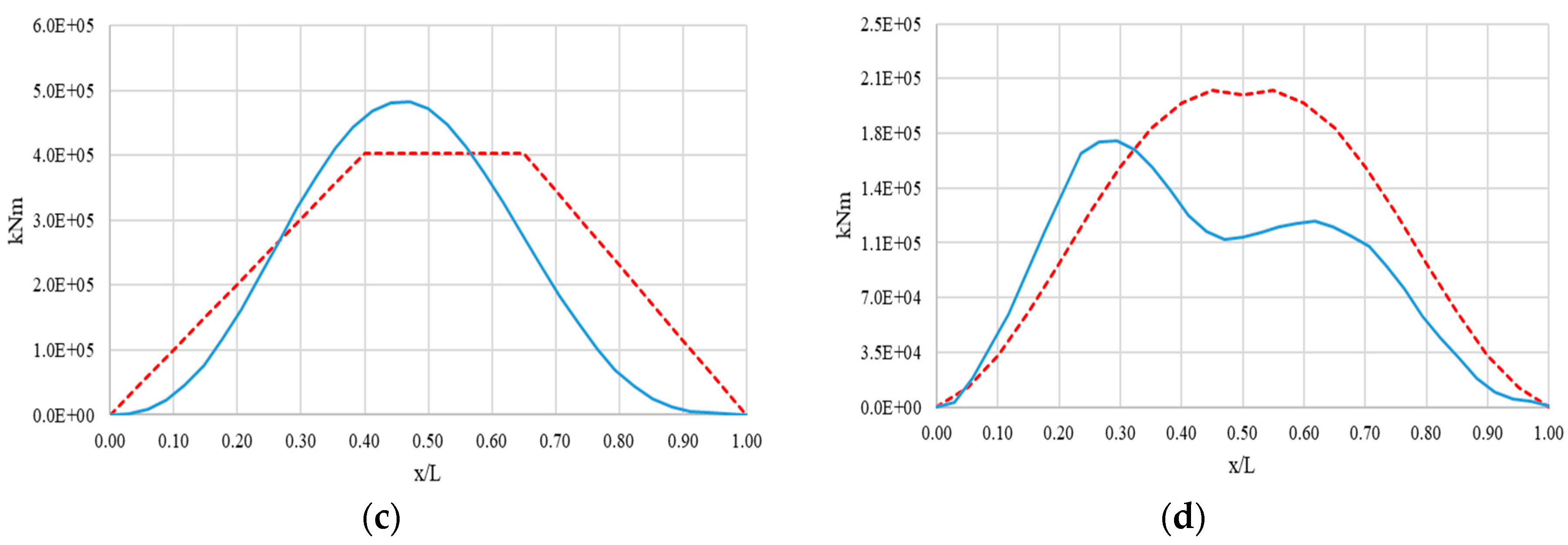
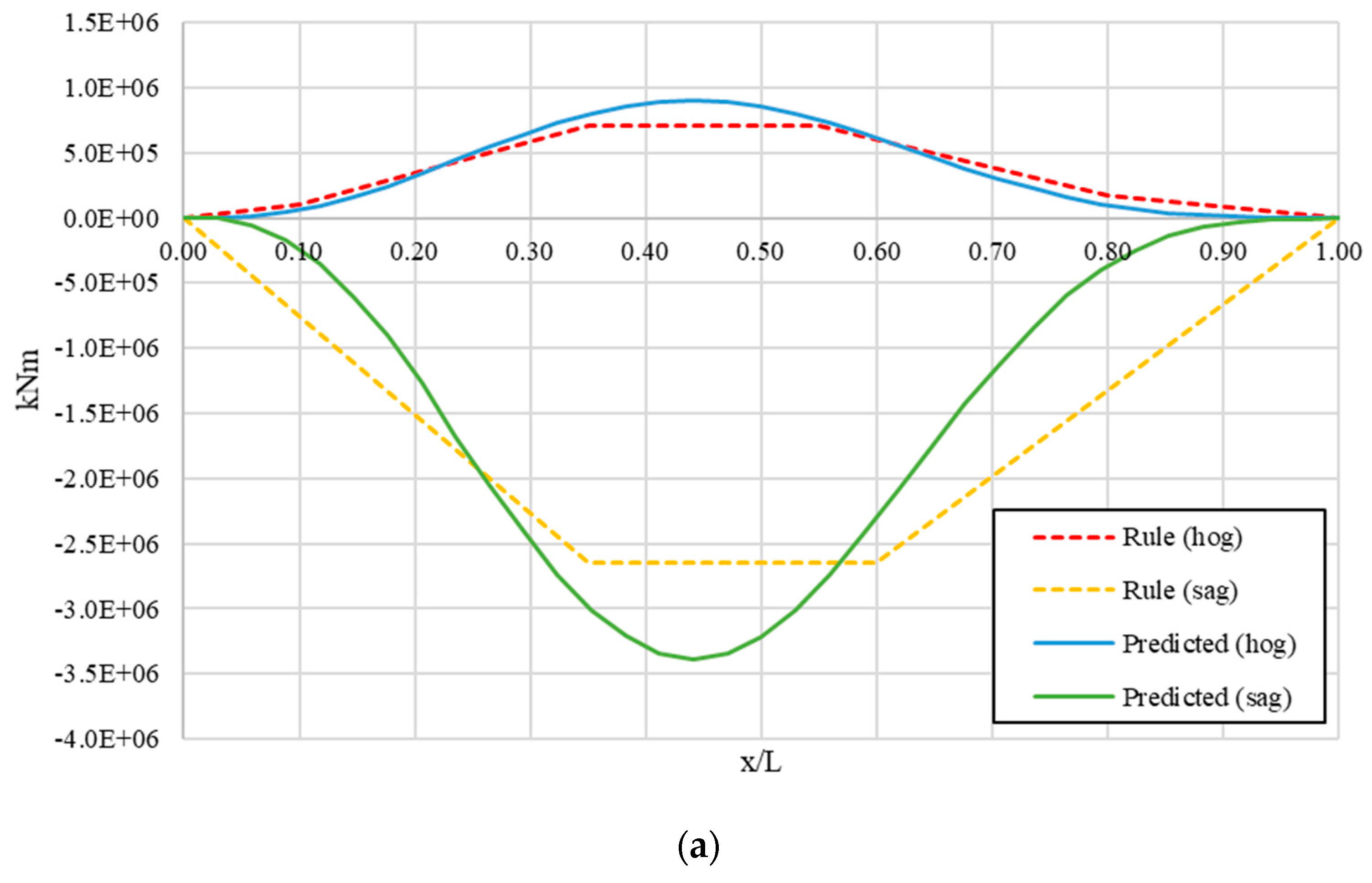

| IACS UR S11 | IACS UR S11A | |
|---|---|---|
| Hogging VBM | ||
| Sagging VBM |
| Ship particular | Symbol | Value |
|---|---|---|
| Length overall (m) | LOA | 200 |
| Gross tonnage | GT | 41,500 |
| Displacement (tonnes) | Δ | 23,000 |
| Element Type | Element Quantity |
|---|---|
| Laminate | 17,463 |
| Plate | 6103 |
| Beam | 10,877 |
| Mass | 51 |
| RBE3 (interpolation) | 51 |
| Total | 34,545 |
| Mode | Dry Frequency (rad/s) | Wet Frequency (rad/s) | Ratio (Wet/Dry) | Structural Damping |
|---|---|---|---|---|
| 7 | 12.56 | 7.94 | 0.63 | 0.002 |
| 8 | 14.56 | 11.75 | 0.81 | 0.003 |
| 9 | 14.92 | 12.79 | 0.86 | 0.007 |
| 10 | 17.27 | 14.29 | 0.83 | 0.005 |
© 2020 by the authors. Licensee MDPI, Basel, Switzerland. This article is an open access article distributed under the terms and conditions of the Creative Commons Attribution (CC BY) license (http://creativecommons.org/licenses/by/4.0/).
Share and Cite
Tilander, J.; Patey, M.; Hirdaris, S. Springing Analysis of a Passenger Ship in Waves. J. Mar. Sci. Eng. 2020, 8, 492. https://doi.org/10.3390/jmse8070492
Tilander J, Patey M, Hirdaris S. Springing Analysis of a Passenger Ship in Waves. Journal of Marine Science and Engineering. 2020; 8(7):492. https://doi.org/10.3390/jmse8070492
Chicago/Turabian StyleTilander, Jeremias, Matthew Patey, and Spyros Hirdaris. 2020. "Springing Analysis of a Passenger Ship in Waves" Journal of Marine Science and Engineering 8, no. 7: 492. https://doi.org/10.3390/jmse8070492
APA StyleTilander, J., Patey, M., & Hirdaris, S. (2020). Springing Analysis of a Passenger Ship in Waves. Journal of Marine Science and Engineering, 8(7), 492. https://doi.org/10.3390/jmse8070492





